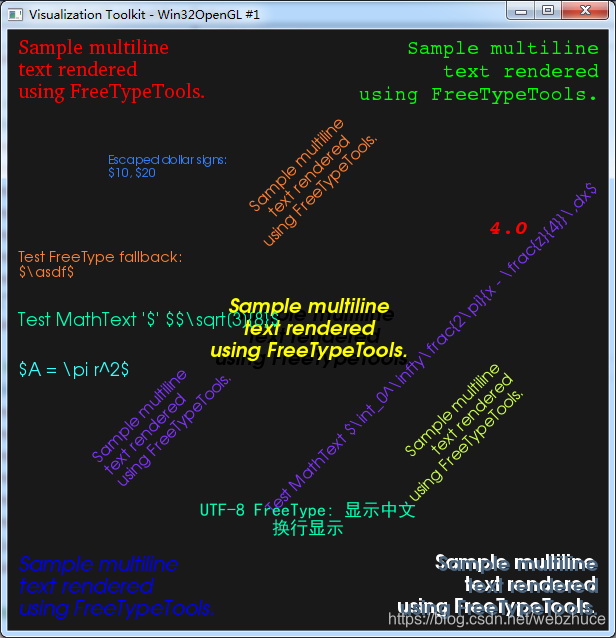基本概念
vtk 5.x版本显示中文是一个比较困难的问题,基本上需要修改底层代码。从vtk 6.1开始,其实中文支持已经不是大问题了。VTK开始支持使用指定的ttf字体文件进行显示了。关键是两个问题:文字使用utf-8格式,比如textActor.SetInput();对vtkTextProperty直接指定使用中文字体文件,比如,simhei.ttf 。例如
vtkNew<vtkTextProperty> tprop;
tprop->SetFontFamily(VTK_FONT_FILE);
tprop->SetFontFile(“/path/to/some/font/file.ttf”);
示例演示
我们绘制不同要求的文字,重点演示如何显示中文。代码如下。
/**********************************************************************
Copyright (c) Mr.Bin. All rights reserved.
For more information visit: http://blog.youkuaiyun.com/webzhuce
**********************************************************************/
#include "vtkTextRenderer.h"
#include "vtkNew.h"
#include "vtkRenderer.h"
#include "vtkRenderWindow.h"
#include "vtkRenderWindowInteractor.h"
#include "vtkStdString.h"
#include "vtkTextActor.h"
#include "vtkTextProperty.h"
#include "vtkSmartPointer.h"
#include "vtkUnicodeString.h"
#include <windows.h>
#include <iostream>
#include <string>
int main(int argc, char *argv[])
{
if (argc < 2)
{
cerr << "Missing font filename." << endl;
return EXIT_FAILURE;
}
std::string uncodeFontFile(argv[1]);
vtkSmartPointer<vtkTextRenderer> tren = vtkSmartPointer<vtkTextRenderer>::New();
if (tren == nullptr)
{
std::cerr << "Object factory cannot find vtkTextRenderer override.\n";
return EXIT_FAILURE;
}
if (strcmp(tren->GetClassName(), "vtkMathTextFreeTypeTextRenderer") != 0)
{
std::cerr << "Object factory returning unrecognized vtkTextRenderer "
"override: " << tren->GetClassName() << std::endl;
return EXIT_FAILURE;
}
std::string str = "Sample multiline\ntext rendered\nusing FreeTypeTools.";
vtkSmartPointer<vtkTextActor> actor1 = vtkSmartPointer<vtkTextActor>::New();
actor1->GetTextProperty()->SetFontSize(20);
actor1->GetTextProperty()->SetColor(1.0, 0.0, 0.0);
actor1->GetTextProperty()->SetJustificationToLeft();
actor1->GetTextProperty()->SetVerticalJustificationToTop();
actor1->GetTextProperty()->SetFontFamilyToTimes();
actor1->SetInput(str.c_str());
actor1->SetPosition(10, 590);
vtkSmartPointer<vtkTextActor> actor2 = vtkSmartPointer<vtkTextActor>::New();
actor2->GetTextProperty()->SetFontSize(20);
actor2->GetTextProperty()->SetColor(0.0, 1.0, 0.0);
actor2->GetTextProperty()->SetJustificationToRight();
actor2->GetTextProperty()->SetVerticalJustificationToTop();
actor2->GetTextProperty()->SetFontFamilyToCourier();
actor2->SetInput(str.c_str());
actor2->SetPosition(590, 590);
vtkSmartPointer<vtkTextActor> actor3 = vtkSmartPointer<vtkTextActor>::New();
actor3->GetTextProperty()->SetFontSize(20);
actor3->GetTextProperty()->SetColor(0.0, 0.0, 1.0);
actor3->GetTextProperty()->SetJustificationToLeft();
actor3->GetTextProperty()->SetVerticalJustificationToBottom();
actor3->GetTextProperty()->SetItalic(1);
actor3->SetInput(str.c_str());
actor3->SetPosition(10, 10);
vtkSmartPointer<vtkTextActor> actor4 = vtkSmartPointer<vtkTextActor>::New();
actor4->GetTextProperty()->SetFontSize(20);
actor4->GetTextProperty()->SetColor(0.3, 0.4, 0.5);
actor4->GetTextProperty()->SetJustificationToRight();
actor4->GetTextProperty()->SetVerticalJustificationToBottom();
actor4->GetTextProperty()->SetBold(1);
actor4->GetTextProperty()->SetShadow(1);
actor4->GetTextProperty()->SetShadowOffset(-3, 2);
actor4->SetInput(str.c_str());
actor4->SetPosition(590, 10);
vtkSmartPointer<vtkTextActor> actor5 = vtkSmartPointer<vtkTextActor>::New();
actor5->GetTextProperty()->SetFontSize(20);
actor5->GetTextProperty()->SetColor(1.0, 1.0, 0.0);
actor5->GetTextProperty()->SetJustificationToCentered();
actor5->GetTextProperty()->SetVerticalJustificationToCentered();
actor5->GetTextProperty()->SetBold(1);
actor5->GetTextProperty()->SetItalic(1);
actor5->GetTextProperty()->SetShadow(1);
actor5->GetTextProperty()->SetShadowOffset(5, -8);
actor5->SetInput(str.c_str());
actor5->SetPosition(300, 300);
vtkSmartPointer<vtkTextActor> actor6 = vtkSmartPointer<vtkTextActor>::New();
actor6->GetTextProperty()->SetFontSize(16);
actor6->GetTextProperty()->SetColor(1.0, 0.5, 0.2);
actor6->GetTextProperty()->SetJustificationToCentered();
actor6->GetTextProperty()->SetVerticalJustificationToCentered();
actor6->GetTextProperty()->SetOrientation(45);
actor6->SetInput(str.c_str());
actor6->SetPosition(300, 450);
vtkSmartPointer<vtkTextActor> actor7 = vtkSmartPointer<vtkTextActor>::New();
actor7->GetTextProperty()->SetFontSize(16);
actor7->GetTextProperty()->SetColor(0.5, 0.2, 1.0);
actor7->GetTextProperty()->SetJustificationToLeft();
actor7->GetTextProperty()->SetVerticalJustificationToCentered();
actor7->GetTextProperty()->SetOrientation(45);
actor7->SetInput(str.c_str());
actor7->SetPosition(100, 156);
vtkSmartPointer<vtkTextActor> actor8 = vtkSmartPointer<vtkTextActor>::New();
actor8->GetTextProperty()->SetFontSize(16);
actor8->GetTextProperty()->SetColor(0.8, 1.0, 0.3);
actor8->GetTextProperty()->SetJustificationToRight();
actor8->GetTextProperty()->SetVerticalJustificationToCentered();
actor8->GetTextProperty()->SetOrientation(45);
actor8->SetInput(str.c_str());
actor8->SetPosition(500, 249);
// Mathtext tests
// Test that escaped "$" are passed through to freetype:
vtkSmartPointer<vtkTextActor> actor9 = vtkSmartPointer<vtkTextActor>::New();
actor9->GetTextProperty()->SetFontSize(12);
actor9->GetTextProperty()->SetColor(0.2, 0.5, 1.0);
actor9->SetInput("Escaped dollar signs:\n\\$10, \\$20");
actor9->SetPosition(100, 450);
vtkSmartPointer<vtkTextActor> actor10 = vtkSmartPointer<vtkTextActor>::New();
actor10->GetTextProperty()->SetFontSize(16);
actor10->GetTextProperty()->SetColor(0.5, 0.2, 1.0);
actor10->GetTextProperty()->SetJustificationToRight();
actor10->GetTextProperty()->SetOrientation(45);
actor10->SetInput("Test MathText $\\int_0^\\infty\\frac{2\\pi}"
"{x - \\frac{z}{4}}\\,dx$");
actor10->SetPosition(588, 433);
// Invalid latex markup -- should fallback to freetype.
vtkSmartPointer<vtkTextActor> actor11 = vtkSmartPointer<vtkTextActor>::New();
actor11->GetTextProperty()->SetFontSize(15);
actor11->GetTextProperty()->SetColor(1.0, 0.5, 0.2);
actor11->SetInput("Test FreeType fallback:\n$\\asdf$");
actor11->SetPosition(10, 350);
// Both $...$ and \\$
vtkSmartPointer<vtkTextActor> actor12 = vtkSmartPointer<vtkTextActor>::New();
actor12->GetTextProperty()->SetFontSize(18);
actor12->GetTextProperty()->SetColor(0.0, 1.0, 0.7);
actor12->SetInput("Test MathText '\\$' $\\$\\sqrt[3]{8}$");
actor12->SetPosition(10, 300);
// $...$ without other text.
vtkSmartPointer<vtkTextActor> actor13 = vtkSmartPointer<vtkTextActor>::New();
actor13->GetTextProperty()->SetFontSize(18);
actor13->GetTextProperty()->SetColor(0.2, 1.0, 1.0);
actor13->SetInput("$A = \\pi r^2$");
actor13->SetPosition(10, 250);
// Numbers, using courier, Text that gets 'cut off'
vtkSmartPointer<vtkTextActor> actor14 = vtkSmartPointer<vtkTextActor>::New();
actor14->GetTextProperty()->SetFontSize(21);
actor14->GetTextProperty()->SetColor(1.0, 0.0, 0.0);
actor14->GetTextProperty()->SetJustificationToCentered();
actor14->GetTextProperty()->SetVerticalJustificationToCentered();
actor14->GetTextProperty()->SetBold(1);
actor14->GetTextProperty()->SetItalic(1);
actor14->GetTextProperty()->SetFontFamilyToCourier();
actor14->SetInput("4.0");
actor14->SetPosition(500, 400);
// UTF-8 freetype handling:
vtkSmartPointer<vtkTextActor> actor15 = vtkSmartPointer<vtkTextActor>::New();
actor15->GetTextProperty()->SetFontFamily(VTK_FONT_FILE);
actor15->GetTextProperty()->SetFontFile(uncodeFontFile.c_str());
actor15->GetTextProperty()->SetJustificationToCentered();
actor15->GetTextProperty()->SetVerticalJustificationToCentered();
actor15->GetTextProperty()->SetFontSize(18);
actor15->GetTextProperty()->SetColor(0.0, 1.0, 0.7);
actor15->SetInput(u8"UTF-8 FreeType: 显示中文\n换行显示");
actor15->SetPosition(300, 110);
// Boring rendering setup....
vtkSmartPointer<vtkRenderer> ren = vtkSmartPointer<vtkRenderer>::New();
ren->SetBackground(0.1, 0.1, 0.1);
vtkSmartPointer<vtkRenderWindow> win = vtkSmartPointer<vtkRenderWindow>::New();
win->SetSize(600, 600);
win->AddRenderer(ren);
vtkSmartPointer<vtkRenderWindowInteractor> iren = vtkSmartPointer<vtkRenderWindowInteractor>::New();
iren->SetRenderWindow(win);
ren->AddActor(actor1);
ren->AddActor(actor2);
ren->AddActor(actor3);
ren->AddActor(actor4);
ren->AddActor(actor5);
ren->AddActor(actor6);
ren->AddActor(actor7);
ren->AddActor(actor8);
ren->AddActor(actor9);
ren->AddActor(actor10);
ren->AddActor(actor11);
ren->AddActor(actor12);
ren->AddActor(actor13);
ren->AddActor(actor14);
ren->AddActor(actor15);
win->SetMultiSamples(0);
win->Render();
win->GetInteractor()->Initialize();
win->GetInteractor()->Start();
return EXIT_SUCCESS;
}
运行结果

参考资料
无




 博客介绍了VTK中文显示相关内容。vtk 5.x版本显示中文困难,需修改底层代码,而从vtk 6.1开始,中文支持问题不大,关键是文字用utf - 8格式,对vtkTextProperty指定中文字体文件,还给出示例代码重点演示中文显示。
博客介绍了VTK中文显示相关内容。vtk 5.x版本显示中文困难,需修改底层代码,而从vtk 6.1开始,中文支持问题不大,关键是文字用utf - 8格式,对vtkTextProperty指定中文字体文件,还给出示例代码重点演示中文显示。
















 1275
1275

 被折叠的 条评论
为什么被折叠?
被折叠的 条评论
为什么被折叠?








